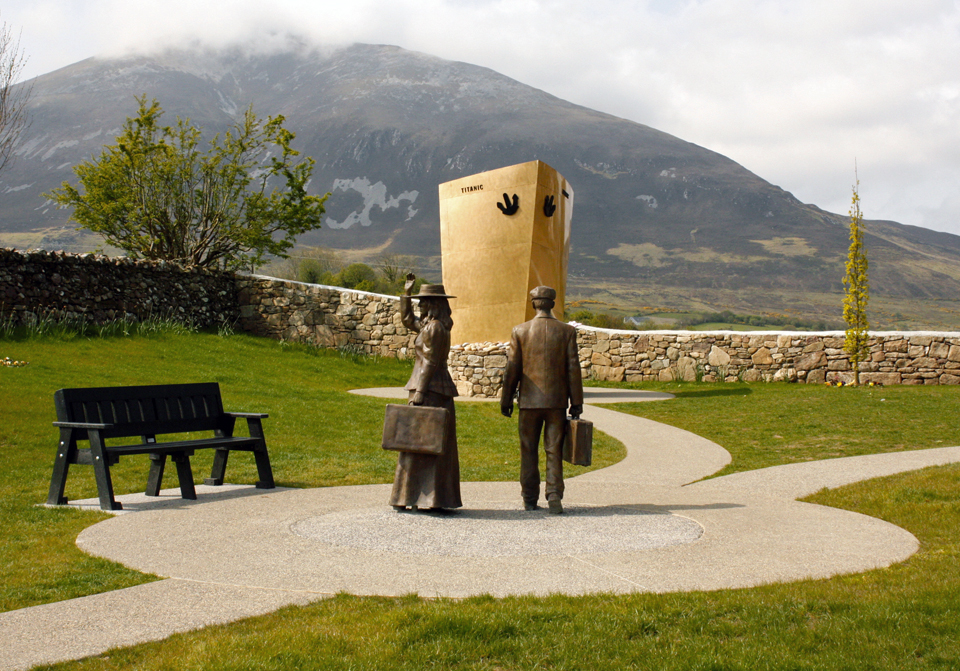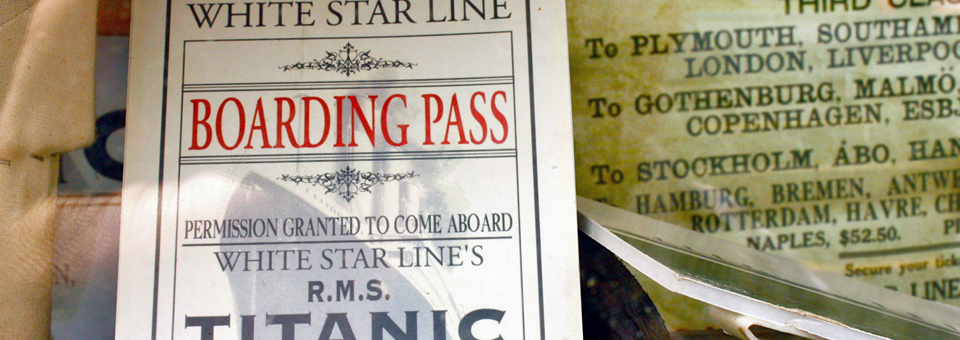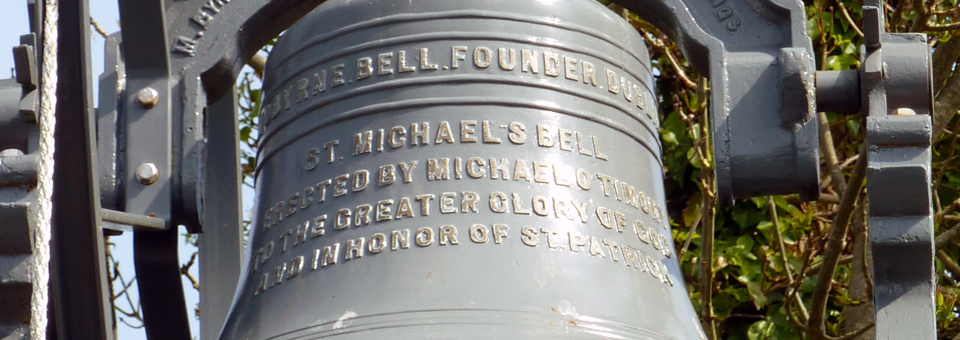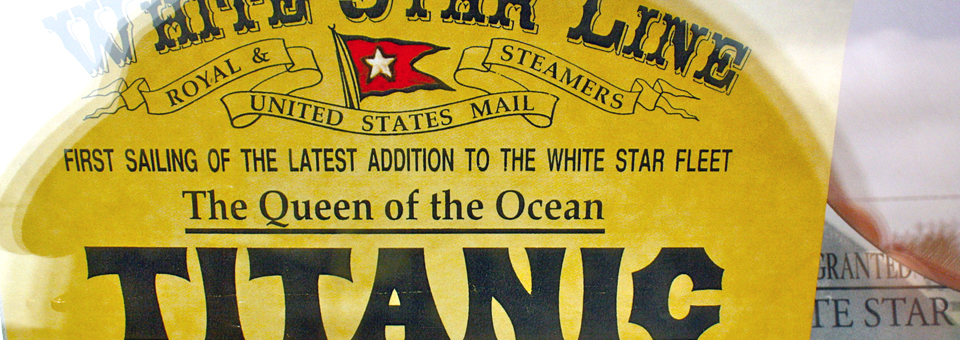Addergoole, Ireland: Titanic adventures in small town Ireland
County Mayo, in the West of Ireland, is a place that now draws vacationers year after year for its outdoor recreation and golf courses. Its rivers and twin lakes region of Lough Conn and Lough Cullin is renowned. Trout abounds and the River Moy is one of the most prolific salmon fishing rivers in the world.
This was also one of the hardest hit areas during the Great Famine since nearly all depended on the potato crop. It was in the village of Addergoole that we discovered a tragedy of Titanic proportions.
A century ago in Ireland, ‘American Wakes’ were held for emigrants. It was likely they would never be seen–or perhaps even heard from–again.
Fourteen people now known as the Addergoole Fourteen traveled from this parish by horse-drawn trap and sidecar to Castlebar railway station. They boarded the 8:23 am steam train for a nine hour journey to Queenstown, in County Cork, to embark on a voyage aboard the largest, most luxurious ship the world had seen–the unsinkable RMS Titanic.
The third class, or steerage, fare, on ships like the RMS Titanic was 7 pounds 15 shillings, and was nearly always borrowed. It was more than half the annual wage for a nurse, but was the price of the dream of a better life for those who left and for those left behind. The ones who emigrated were expected to send money home to help support the family, for dowries so younger sisters could marry, and for other family members to emigrate.
At 11:40pm on April 14, after sailing for four days, the RMS Titanic struck an iceberg. It sank two hours and forty minutes later into Newfoundland’s icy waters. Seven hundred of the 1500 passengers survived. Only three were from Addergoole.
The parish experienced what is believed to be the disaster’s largest proportionate loss of life. The eleven passengers from this community who perished represented 0.3% of the 1911 census population of 3,496 and 2% of all Third Class passengers lost.
The dreams of the Addergoole families left behind sank with the ship. Younger sisters of those who perished were left as spinsters. Others were resigned to remain in poverty without the opportunity to seek a brighter future.
The community still mourns. There has been a mass at St. Patrick’s Church in the village of Lahardane every year since the tragedy in 1912.
The Timoney Bell in the churchyard memorializes those who perished on the “Ship of Dreams”. It is rung every April 15 at 2:20 AM–once for each victim, followed by three joyful rings for those who survived.
Across from St. Patrick’s Church, the windows of Leonard’s were filled with displays on the Titanic disaster.The Addergoole Titanic Society was formed in 2002 to research, record, and preserve information and artifacts related to the Titanic story. The mission is to make people aware of Addergoole’s role in this tragedy, and to commemorate it in tangible ways.
A plaque in the church lists the names of the Addergoole Fourteen, and fourteen trees were planted on the primary school grounds.
In honor of the 100th anniversary of the sinking of RMS Titanic in 2012, signs have been erected identifying Addergoole as Ireland’s Titanic village.
The Addergoole Titanic Memorial Park, which opened April 15, 2012, includes sculptures and information boards that tell the story.
Stunning and unique stained glass windows inside the church are labeled “Emigration” and “The Titanic Rescue”.
The “Emigration” window memorializes all who left Addergoole parish, wherever they settled.
“The Titanic Rescue” window is thought to be the only Titanic-themed church window in the world. It is based on the recollections of Titanic survivor Annie Kate Kelly, who became a Dominican sister in Chicago, and shows Lifeboat 16 being lowered.
Annie was waiting in line for boat 16 when John Bourke, who was with two women, was denied boarding. One was his wife, Catherine Bourke, who had traveled to the US in 1905, returned to home to Ireland in 1911, and married him in this church. The other was his sister, Mary Bourke. Both refused to leave him. Annie Kate Kelly boarded the boat.
She looked up when the lifeboat was lowered and saw two of the men from Addergoole parish. They were James Flynn and her cousin, Pat Canavan, who was holding his rosary and waving.
Families of the Titanic passengers waited for weeks for bodies to be found and identified. Body #61 was identified as Mary Mangan. Her name was on the back of her watch, which was returned to the family.
What became of the survivors?
Annie McGowan married Ray Straube and had three daughters. She died in 1990 at age 95 and is buried in Illinois.
Delia McDermott’s family bought her the hat and gloves that they felt a lady should wear in America. She left her lifeboat to retrieve them, but managed to get on another one. She married John Lynch and had two daughters and a son. She died in 1959 at age 78 and is buried in New Jersey.
Annie Kate Kelly, who took the place of the Bourke sisters in the life boat, became a teacher and Dominican nun, Sister Patrick Joseph. She visited Addergoole in the 1950s, died in 1969 at age 77, and is buried in Michigan.
Former President of Ireland Mary Robinson opened the ceremonies for Addergoole Titanic Cultural Week, held April 8-15, 2012. She spoke of the light she keeps in her window in memory of the Irish emigrants around the world. Tens of thousands of people attended.
The story lives on. The schoolchildren of Addergoole gathered accounts from their families and made drawings of their history. They placed them in a time capsule that will be opened in 25 years.
Ready to discover Ireland?
















I have just finished reading the novel by Hazel Gaynor titled the “Girl Who came Home”. It is a fantastic retelling of what these people went through. It gives you a whole different outlook when you read what their feelings at the time where. I feel like I know these people now. Thank you for keeping their memories alive through this foundation which is listed at the end of the book.
I hope you have the opportunity to visit this area. We hear so often about the rich and famous on the Titanic. It is especially touching to get a sense of how profoundly the families of this town were affected.